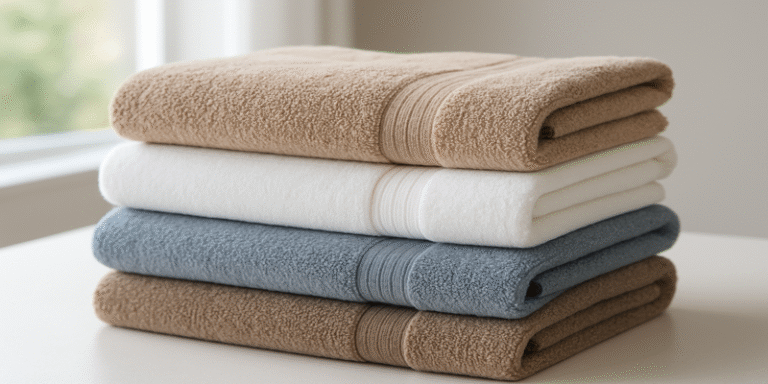Maintaining proper hygiene within domestic environments is crucial, and one everyday item frequently overlooked in this regard is the humble towel. Towels, while serving as key tools for personal cleanliness, can ironically become breeding grounds for bacteria and fungi when not properly cleaned. This article explores how often we should wash our towels based on microbiological evidence, hygiene standards, and dermatological health, drawing upon guidance from health authorities, peer-reviewed journals, and scientific textbooks.
The Science Behind Dirty Towels
Towels readily absorb moisture and retain warmth, providing an ideal environment for microbial proliferation. Research shows that bath towels can harbour a wide range of microorganisms including Escherichia coli, Staphylococcus aureus, and moulds if left damp and unwashed for extended periods (Bloomfield et al., 2011). These microbes thrive in the fibrous material of the towel, particularly when hung in poorly ventilated bathrooms.
A 2024 study by Enchill et al. analysed towels used by university students and found high contamination with faecal coliforms and skin flora, suggesting that towels can act as reservoirs for pathogenic bacteria if not laundered regularly. They recommended that towels be washed at high temperatures and dried thoroughly to reduce bacterial load (Enchill et al., 2024).
What Do Experts Say?
Several health organisations have issued recommendations on towel hygiene. The Mayo Clinic and Healthline suggest washing bath towels every three to four uses, or at least twice per week, especially in humid climates where towels take longer to dry (Huang et al., 2012; Healthline, 2020). The NHS does not provide an explicit rule on towel washing frequency but recommends regular laundering of all household linen to prevent the spread of infections.
Cleveland Clinic further highlights that people with compromised immune systems, skin conditions, or acne should consider washing towels after every use, as bacteria and oils can exacerbate dermatological issues (Cleveland Clinic, 2021).
Skin Health and Towel Hygiene
Towels, when not washed frequently, can contribute to skin irritation, clogged pores, and even fungal infections. A systematic review by Blume‐Peytavi et al. (2012) indicated that using clean, dry towels supports skin barrier function and prevents secondary skin infections, particularly in infants and elderly populations. The American Journal of Infection Control underscores that frequent laundering of towels reduces skin bacteria by over 90% (Aiello & Larson, 2008).
Furthermore, the rough texture of used towels can cause microabrasions that allow bacteria to penetrate the skin more easily. This is especially concerning for individuals with eczema or open wounds, where clean towels are essential for infection prevention (Bissett, 2007).
Microbiological Risks in Towel Usage
Microbiologists have examined towel contamination in both domestic and clinical settings. Vandegrift et al. (2017) studied bacterial communities in household towels and found that coliform bacteria can survive several wash cycles if not washed at ≥60°C. Similarly, a 2021 study from Springer showed that residual bacteria and fungi could persist even after machine washing if low temperatures or insufficient detergent were used (Suen et al., 2019).
Reusable hand towels in shared environments, such as gyms or dormitories, present even higher microbial risk. Bloomfield et al. (2006) highlight how shared towels can transmit methicillin-resistant Staphylococcus aureus (MRSA) and other pathogens, particularly when hygiene compliance is low.
Towel-Washing Guidelines Based on Use
The frequency of washing towels should be determined by their use case:
| Type of Towel | Recommended Washing Frequency | Rationale |
| Bath towels | Every 3 uses | Accumulate sweat, skin cells, and bacteria |
| Face towels | Daily | Touch sensitive facial skin; risk of acne and eye infections |
| Gym towels | After every use | Exposure to sweat and communal surfaces |
| Kitchen towels | Daily or after food prep | Risk of cross-contamination with foodborne pathogens |
| Guest towels | After each use or each visitor | Ensure hygiene for multiple users |
Source: Adapted from recommendations by Healthline (2020), Mayo Clinic (2012), and Bloomfield et al. (2011).
Best Practices for Washing Towels
To ensure towels are effectively cleaned and disinfected:
- Wash towels at 60°C (140°F) with detergent; add bleach or vinegar for added disinfection (Bloomfield et al., 2011).
- Dry towels completely using a tumble dryer or in sunlight to eliminate residual moisture.
- Avoid fabric softeners as they reduce towel absorbency and may leave residue.
- Separate towels from underwear or heavily soiled items to prevent cross-contamination.
- Use a clean towel after illness or skin infection to avoid reinfection.
Environmental and Practical Considerations
While frequent washing is hygienic, it can raise concerns about energy and water use. Konya et al. (2021) recommend that individuals who live alone and maintain good hygiene may safely extend the interval between washes if towels are hung to dry completely after each use. The European Tissue Symposium also notes that drying and airing towels in sunlit, ventilated environments can reduce microbial load without a full wash (Bloomfield et al., 2011).
Eco-conscious laundering practices, such as using cold cycles with disinfectants or natural drying, may offer a middle ground between hygiene and sustainability.
Towels, though often overlooked in household hygiene routines, can harbour a significant microbial burden if not washed frequently and correctly. The general consensus among healthcare experts and researchers suggests that towels should be washed at least every three uses, more often for facial or gym towels, or when used by individuals with compromised immunity or skin conditions.
The balance between hygiene, skin health, and environmental sustainability should inform individual laundering habits. Ensuring proper towel hygiene is not only a matter of cleanliness—it is a simple, yet powerful act in infection control and skin protection.
References
Aiello, A.E., Larson, E.L., & Sedlak, R. (2008). Personal health bringing good hygiene home. American Journal of Infection Control, 36(10), S152–S165. https://www.ajicjournal.org/article/S0196-6553(08)00741-4/pdf
Bissett, L. (2007). Skin care: an essential component of hand hygiene and infection control. British Journal of Nursing, 16(16), 1020–1024.
Bloomfield, S.F. et al. (2011). The infection risks associated with clothing and household linens. International Scientific Forum on Home Hygiene. https://europeantissue.com/wp-content/uploads/The-infection-risks-associated-with-clothing-and-household-linens.pdf
Cleveland Clinic. (2021). How Often Should You Wash Your Towels? https://health.clevelandclinic.org
Enchill, G.A., Nyamson, J., Larbi, E. & Arko, C.O. (2024). Bath Towel Bacterial contamination and Hygiene practices among Tertiary Students. West African Journal of Applied Ecology. https://www.ajol.info/index.php/wajae/article/view/284710
Healthline. (2020). How Often Should You Wash Your Towels? https://www.healthline.com
Huang, C., Ma, W. & Stack, S. (2012). The hygienic efficacy of different hand-drying methods: a review. Mayo Clinic Proceedings, 87(8), 791–798.
Konya, I., Nishiya, K. & Yano, R. (2021). Effectiveness of bed bath methods for skin integrity. Nursing Open, 8(5), 2523–2533.
Suen, L.K.P. et al. (2019). The public washroom—friend or foe? Antimicrobial Resistance & Infection Control, 8, 63.
Vandegrift, R. et al. (2017). Cleanliness in context: reconciling hygiene with a modern microbial perspective. Microbiome, 5, 76.









